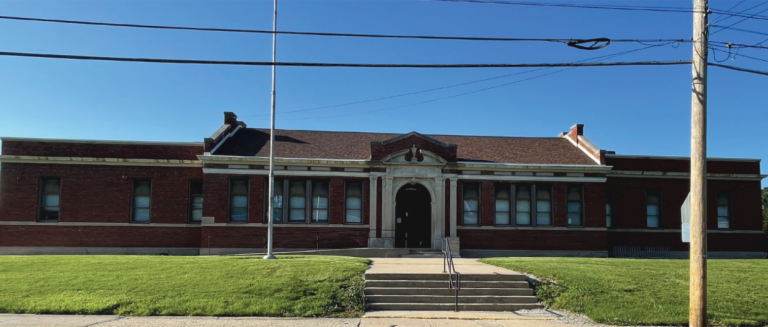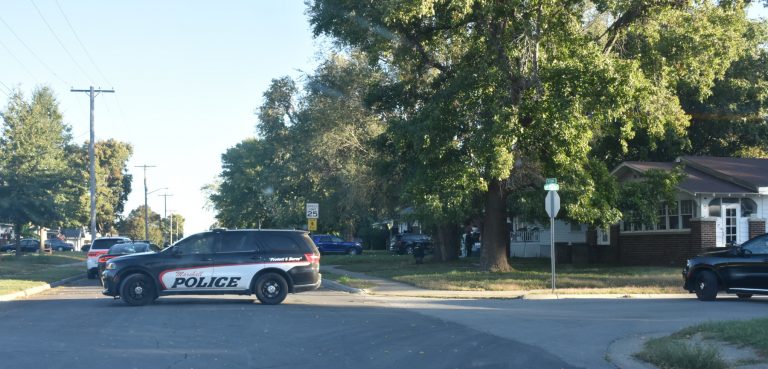City officials weigh options for historic building
By Whitney Barnes
Staff Writer
The future of the Eastwood Elementary School property hangs in the balance as Marshall city officials grapple with its potential demolition and the implications for the community. Mayor Vince Lutterbie addressed the situation during a recent city council work session, emphasizing that discussions regarding the school are ongoing and do not involve Benton or Northwest schools.
In 2018, when the city acquired the Habilitation Center property from the state, there were limited options available, Lutterbie explained, one of which involved partnering with the public school system.
Since selling the land or developing housing wasn’t feasible, Lutterbie said they pursued what they believed was the best deal by allowing the school to take over a portion of the land.
In return, the school would handle the infrastructure work, which would save the city money in the long run. Essentially, this agreement allowed them to trade the land for what they considered the best potential commercial property, specifically Eastwood Elementary School.
“We were in the middle, at that time, of demolishing the (former) Fitzgibbon Hospital and … working on the tanks in the ground and all that work, and we realized how expensive that could possibly be,” Lutterbie said. “So, we asked the school to put up … an agreement … on that $500,000.”
He noted that the school earmarked that money to cover the demolition of Eastwood if needed, and that remains the current understanding of their agreement.
“If we just let the contract stand as it is right now, the school will be demolished,” Lutterbie said.
He expressed concern about the funding for potential demolition, highlighting that the city currently lacks the necessary resources to address the building if issues arise.
“We were worried about funding … if something, let’s just say somebody took over the building and somehow it defaulted to the city, we don’t have the advantage of having ARPA funds available at this point and other funds to tear it down if it becomes a big problem. We still may have to deal with Northwest and Benton, maybe even Southeast, so we’re not wanting too many old buildings on our docket.”
Lutterbie invited City Administrator JD Kehrman to discuss the contract terms as written.
Kehrman explained that the contract executed with the school district on March 19, 2024, includes an agreement for the school district to deliver the Eastwood tract to the city, with the building and any environmentally sensitive materials abated by no later than May 30, 2026. This arrangement comes in exchange for the Hab Center property currently under construction, which had been transferred to the district the previous year.
Lutterbie mentioned that Marshall Public Schools Superintendent Caleb Petet indicated a preference for a final decision from the council by March or April, so the school board could finalize their budget and plan accordingly.
Council member Dan Brandt expressed his fondness for the Eastwood Elementary School due to his long-standing ties to it but raised concerns about its future. He drew a parallel to the former Fitzgibbon structure, noting the risk that a high bidder might acquire the property only to abandon it later, which could lead to vandalism and other issues.
Brandt acknowledged the environmental risks associated with a building from the 1920s, especially considering potential hidden tanks and contamination from historical heating methods.
He explained that without ARPA funds, the situation with properties like Fitzgibbon and the Hab Center would have been much worse. Ultimately, he concluded that despite his reluctance, the best course of action would be to adhere to the existing contract. That was his perspective on the matter.
Realtor Sandy Hisle countered the demolition narrative, expressing an interest in reviving the property.
“Structurally, it’s still sound,” said Hisle, suggesting that with proper investment, the building could be transformed into high-end apartments, similar to successful projects across the country.
As deliberations continued, Mayor Lutterbie shared that when he spoke with the superintendent, it was clear the school board wanted a $500,000 issue resolved within two months for planning purposes. He noted that there might not be a guarantee to hold that amount while they pursue requests for proposals (RFPs).
Hisle raised the possibility of selling the building at auction instead of through an RFP process, but Lutterbie emphasized the risks involved.
Kehrman pointed out that they would have to take possession of the building as-is, and any attempt to sell at auction without addressing environmental issues could complicate matters legally.
Hisle proposed a method where offers could be taken, and once the purchase was finalized, the property could be immediately sold to a buyer who would take on all responsibilities.
Council member Jim Papreck asked Hisle, as a developer, if she would agree to include a clause in the contract stating that she would be responsible for the building’s demolition if necessary.
Hisle confirmed that any developer would have to take such responsibility, noting that financing would be contingent on their commitment to the project and not abandoning it.
Hisle mentioned that the sale could involve stipulations, like a time frame to complete renovations and potential financial arrangements if the project wasn’t finished within a particular period. She emphasized the importance of maintaining historical buildings and finding the right developer to ensure the building’s preservation. Hisle also pointed out that with proper planning, work could commence efficiently during ideal conditions.
She reiterated her belief that the building could be saved, citing its sound structure and the relative ease of converting the existing rooms into apartments.
“I have already, I’ve already put numbers to it … to calculate what it would take to rent, what I think it will cost to rehab it,” Hisle said. “… I’m figuring about $60,000 a unit, and I believe there are 13 units in it. And then I have calculated … the return on it; what it would take rent-wise to do that.
She also noted that if the abatement of materials like asbestos tiles was necessary, as an independent contractor, they could handle that work themselves, resulting in significant cost savings compared to hiring a city crew.
“Before you tear it down, if you could at least reach out, I think there are more people than myself that are interested,” Hisle said.
Council member Steve Cook expressed his personal opinion, suggesting that if Hisle or another potential buyer could reach an acceptable agreement with the school, he would support abandoning the city’s contract and allowing that sale to proceed without city interference.
Council member Drew Green expressed some agreement with Cook’s suggestion about negotiating with the school, but noted that the initial agreement involved demolishing the building with the understanding that the city would retain the land and sell it afterward.
“If that happened, I would want them to give us whatever money they sold it for, because that was part of the deal for the school,” he said. “… That was part of the … (trade). … The citizens gave them that. We want something for our trade. We got return of a clear piece of land. I’m just saying I don’t want that money to go to the school. It should go to the city. It should go to the citizens that owned it.”
Green questioned the practicality of demolishing the building to make way for apartment complexes. In response, Hisle highlighted the potential of refurbishing the building, estimating that an apartment project could cost between $750,000 and $1 million, while constructing a new one could range from $3 to $4 million.
Green acknowledged the issue surrounding the city possibly ending up with properties that don’t meet initial expectations after various transactions, making it clear that the city is cautious about assuming liability for rundown buildings. He noted past experiences where the city had been left with deteriorated structures and expressed the need for a contract that could provide some safeguards against future liabilities.
Hisle suggested conducting background checks on any prospective buyers to ensure they possess the necessary qualifications and experience for such projects.
Papreck raised a point about crafting a contract that includes three parties: the school, the city, and a developer. He proposed that possession could transfer directly from the school to the city and then to the developer, with the developer providing collateral to ensure compliance with terms, reverting ownership back to the city if the project fails within a specified timeframe.
The city counselor acknowledged the complexity of such a contract while still pointing out the risk of developers lacking sufficient resources.
Lutterbie commented that if an agreement is reached between the buyer and the school, the city would be open to reviewing it. He noted that there was a 60-day window for this process, as the city had not yet taken possession of the building.
Green inquired whether Hisle could buy the property directly from the school, to which Lutterbie confirmed that the city would need to cancel the current contract and approve the sale, which would mean a loss of the $400,000 to $500,000 value.
Green questioned the implications of this financial loss, to which Lutterbie clarified that while it would be a loss in potential revenue from demolition, the city would also claim responsibility should the situation deteriorate further.
Marshall Public Library Director Matt Rahner emphasized that the land in question has seen significant taxpayer investment for over a century. He expressed his openness to the idea of it being developed into a commercial space or an apartment complex but also noted that a portion of the seven acres could be utilized as park land or an additional city park.
He mentioned the school’s plan to spend approximately $350,000 to tear down the existing structure. Rahner suggested that if the school provides this amount in cash, the property could be sold, and if the development doesn’t proceed as planned, that funding could be used for demolition, allowing the city to retain ownership of the land.
Lutterbie responded by highlighting that while the school would absorb the initial $350,000, any costs exceeding that amount would fall to the city once they accept the cash. He emphasized the risk of losing their financial guarantee if expenses rise beyond that figure.
Rahner then proposed the idea of stipulating that if the developer fails to follow through, they would be responsible for any shortfall, but Lutterbie dismissed this as unlikely.
“They’re absolutely not going to do that,” Lutterbie said.
Green pointed out that contracts might seem like guarantees, but they often hold little weight in reality from a developer’s perspective.
Lutterbie indicated his willingness to consider the land as a park or green space, depending on ownership status at that time.
Rahner suggested selling just the building while maintaining some of the land, but Lutterbie clarified that the current contract prohibits that option, requiring an all-or-nothing decision.
“We all want it to be apartments or something like that; none of us really like the idea of the architecture and losing the building; I just think we’re all very gun shy because of what’s happened in the past,” Green said.
He continued, “You mentioned the $350,000; that’s a great idea to put it away; unfortunately, when you carry that out four years from now, you’re talking $500,000-plus in four years to abate that building it just keeps getting more expensive, and so I guess the question, is how do you get all the citizens to reply about, ‘Hey, we’re willing to pay that.’”
Lutterbie mentioned the rationale behind broadcasting the discussion on YouTube, seeking public feedback, especially given that taxpayers would ultimately bear the expenses.
Rahner reiterated the unfairness of handing the land over to a private developer after years of taxpayer contributions.
Lutterbie reflected on past governmental decisions, likening their current stance to previous situations that yielded unsatisfactory outcomes without the school’s backing.
Before closing, Lutterbie noted that the work session was not meant to conclude a decision, but to present information and solicit citizen input. He proposed revisiting the matter in March to assess community feedback.




